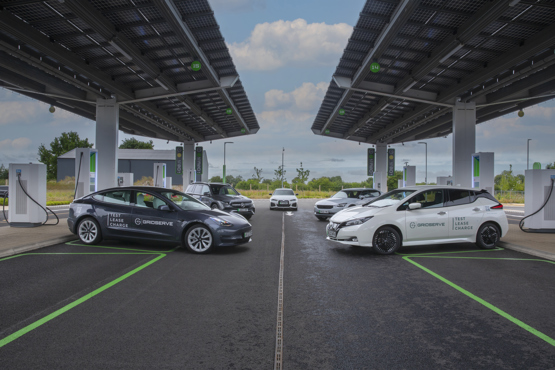
Harnessing EVs as assets for energy storage may help stability calls for on {the electrical} grid and make renewable sources extra useable, writes Doron Frenkel
The electrical car (EV) motion has handed the purpose of no return.
Automakers are speeding new EV fashions to market and in lots of circumstances, they’re committing most or all their R&D to EVs and battery know-how. Coverage makers are pushing arduous with each incentives and laws. Funding is flowing into charging infrastructure, made extra engaging by new requirements assuring interoperability. Enterprises and public transportation operators are electrifying their fleets. And, maybe most significantly, folks need it.
It’s now secure to say that the EV future is simply across the bend. However how will we benefit from it?
In getting there, a chance emerges. Trade can redefine EVs as greater than a way of transportation powered by electrical energy to switch fuel guzzling inner combustion engines. Past roaming the streets and highways with zero emissions, these cellular batteries have a but untapped potential to additional cut back carbon emissions from energy technology, maybe by as a lot as 50%.
Essentially the most impactful advances for local weather change can come from utilizing EV batteries as storage assets that can be utilized to stability peak calls for on producing capability and fixing the supply problems with renewables
Whereas everybody recognises the potential for EVs to create a cleaner local weather, when in comparison with their ICE counterparts, it’s important to leverage their advantages within the broader context of what EVs may imply for ‘local weather recharge’. Essentially the most impactful advances for local weather change can come from utilizing EV batteries as storage assets that can be utilized to stability peak calls for on producing capability and fixing the supply problems with renewables.
First, let’s unpack the issues. Visualising peak calls for on electrical energy technology is straightforward. Image rolling brownouts on scorching summer season afternoons in America’s south and west. With everybody at work and air conditioners cranking to maintain folks snug, the demand for electrical energy exceeds capability. Setting apart the extremes of brownouts, electrical energy in these peak intervals is costlier.
As to renewables, they maintain the promise of breaking the present dependency on coal-fired technology to energy the longer term and cut back carbon emissions. However you should solely look outdoors to see the issue. If the solar is shining or the wind is blowing, renewable vitality is plentiful and low cost. But when not? How can we modify vitality provide to demand?
A world stuffed with EV batteries modifications every part. The query for each balancing technology and increasing using renewables is how we retailer that vitality for later use. EV batteries, mixed with sensible vitality administration, are the reply. Right here’s how that works, and all of us play a job. The magic begins with the elemental shift in when and the place fuelling takes place. As an alternative of fuel stations, most EV charging occurs at dwelling and work.
That reality is so blindingly apparent it hides the profound impression EVs can have on local weather recharge. Inexperienced-minded EV homeowners can re-charge and retailer electrical energy of their large-capacity batteries on the proper instances when electrical energy is local weather pleasant and cheaper. Whether or not at dwelling at evening when demand is low, or when the winds are blowing, or the solar is shining, it’s a win-win. Then they can provide again extra vitality when it’s most wanted and costly, reducing peak technology calls for, in addition to CO2 emissions.
And inexperienced on this context is just not solely eco-altruism. They’ll revenue on storing electrical energy for the grid: shopping for low and promoting again excessive at a premium.
There may be loads of room to do that whereas nonetheless taking drivers’ wants into consideration. The typical American drives 29 miles a day, in line with the U.S. Bureau of Transportation. Even in case you assume a four-fold security margin and a mean 250 mile vary EV battery, that also leaves greater than 50% capability out there for local weather recharge. This sounds good for fixing the storage points with grid balancing and renewables, however how is that this vitality optimisation managed?
Enter sensible vitality administration, a holistic system that integrates EVs, energy grids and every part in between to mechanically modify electrical energy supply to or from EVs. Primarily based on algorithms that make be aware of dynamic grid and renewable provides, pricing and the driving wants of car homeowners, vitality administration offloads stress from the grid throughout peak charging intervals and preserves vitality from renewables for later use, decreasing prices and growing the effectivity of vitality utilization.
The implications listed here are immense—EVs are now not solely a way of transportation, they could generate income and turn out to be brokers of local weather recharge. With managed charging, they are often grid property. Automobiles may energy buildings, microgrids and even feed vitality again into communal energy techniques, successfully creating a versatile vitality market that won’t solely meet—however exceed—the calls for of EVs, and in the end gas local weather recharge.

Now, EV charging demand is shifted away from peak intervals, circumnavigating important stress on the grid and making charging cheaper for customers. Along with receiving decrease charges, networks can earn fee incentives and even promote vitality again to the grid. Sensible EV charging administration permits this complicated interplay between planning and automation required to carry versatile vitality markets to fruition.
These options usually are not solely efficient, however important. McKinsey analysis believes that unmanaged, substation peak-load will increase from EV charging energy demand will finally push native transformers past their capability, requiring costly infrastructure upgrades in the long run. At current, industries usually are not making the most of the chance introduced to the— leveraging sensible charging know-how as an agent of change—as an alternative ignoring the larger image in favour of siloed pondering.
Sure, the local weather recharge initiative has begun, however solely by recognising the advantages of EVs as cellular batteries can we carry the entire image of prospects to fruition. We are able to begin with collaboration and schooling.
In regards to the creator: Doron Frenkel, founder and Chief Govt of Driivz, is an skilled entrepreneur with a robust monitor file of excellence and government management in worldwide IT, telecom and electrical automobiles organisations








